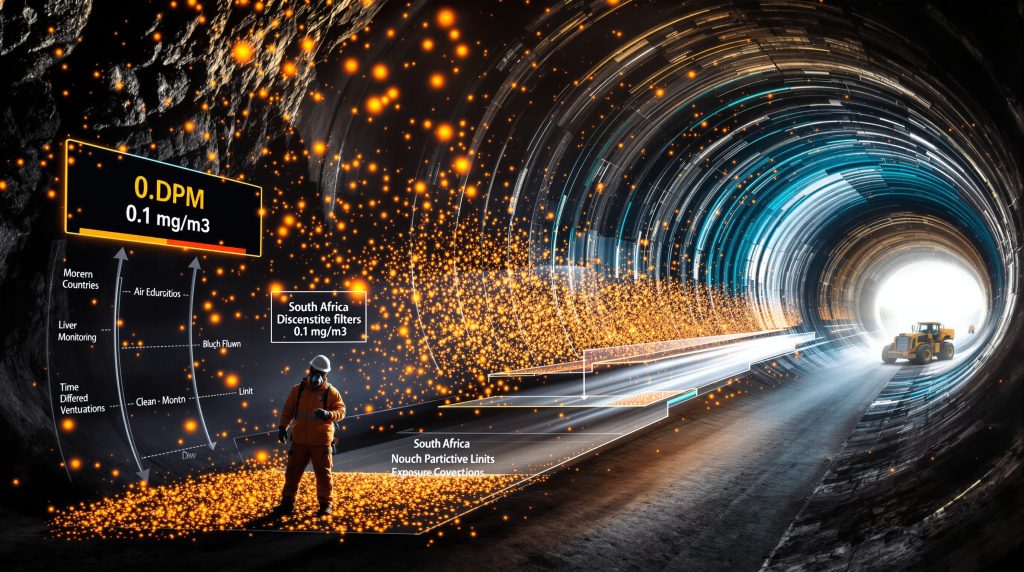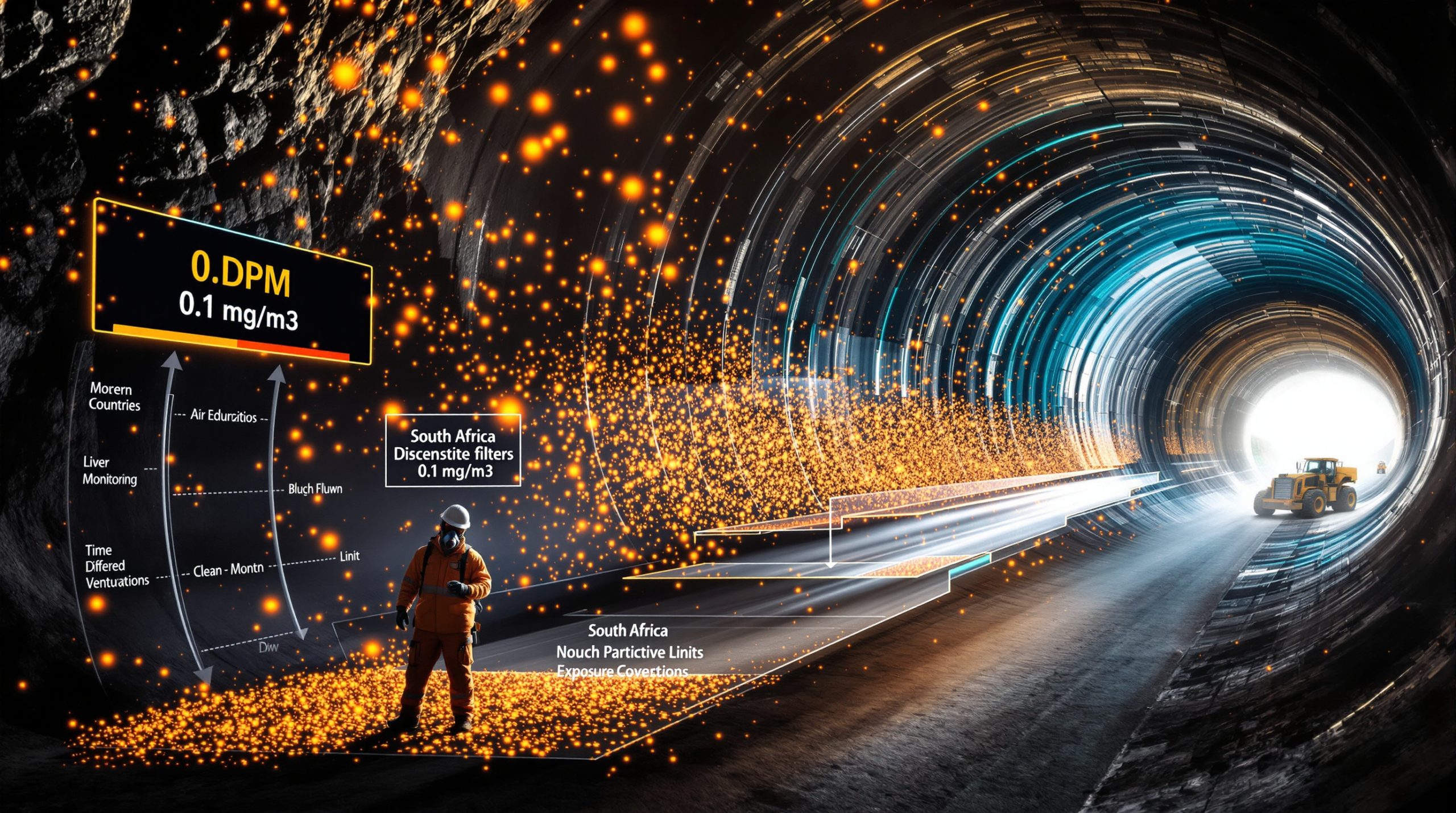What is Diesel Particulate Matter and Why is it Dangerous?
Diesel Particulate Matter (DPM) consists of microscopic solid particles and liquid droplets formed during the combustion process in diesel engines. These ultrafine particles primarily contain elemental carbon surrounded by organic compounds, sulfates, nitrates, and trace metals. With particles typically measuring less than 2.5 micrometers in diameter, DPM is particularly hazardous because it can bypass the body's natural defense mechanisms.
The health risks associated with DPM exposure are significant and well-documented. When inhaled, these microscopic particles can penetrate deep into the lungs and even enter the bloodstream, triggering or worsening various health conditions. Studies have shown that mining workers exposed to high DPM levels can have 2-7 times higher risk of lung cancer compared to the general population.
Key health concerns include:
- Respiratory issues including bronchitis, asthma, and reduced lung function
- Cardiovascular problems such as heart attacks and irregular heartbeat
- Neurological effects including cognitive impairment
- Potential immune system disruption
- Increased cancer risk, particularly lung cancer
The International Agency for Research on Cancer (IARC) classified diesel engine exhaust as a Group 1 carcinogen in 2012, confirming its cancer-causing potential in humans. This classification places DPM in the same category as asbestos, benzene, and tobacco smoke—substances definitively linked to cancer development.
Recent research highlights: Scientists have found that the smallest DPM particles can cross the blood-brain barrier, potentially contributing to neurological conditions. Additionally, long-term exposure has been associated with increased mortality rates even at exposure levels previously considered safe.
How are DPM Exposure Limits Changing in South Africa?
Current Regulatory Status
Until recently, South Africa's approach to DPM exposure in mining environments lacked legally binding standards. Mining operations primarily relied on international benchmarks and voluntary guidelines to manage worker exposure levels. This created inconsistent protection for workers across different mining operations and made enforcement challenging for regulators.
The absence of specific legal requirements meant that DPM management often depended on individual company policies and their commitment to worker health initiatives. Some mining operations implemented robust controls based on international best practices, while others maintained only minimal protection measures.
New Legal Framework Taking Effect
Beginning June 26, 2025, South Africa will implement a landmark change with legally enforceable occupational exposure limits (OELs) for DPM under amendments to the Mine Health and Safety Act (MHSA). This represents a significant step forward in worker protection.
Key aspects of the new regulatory framework include:
- Specific exposure limit: 0.1 mg/m³ for elemental carbon (EC), measured as an 8-hour time-weighted average
- Compliance timeline: Mining operations will have a 90-day window from implementation to achieve full compliance
- Measurement methodology: Elemental carbon will serve as the primary marker for quantifying DPM exposure
- Enforcement mechanism: The Department of Mineral Resources and Energy will oversee compliance through regular inspections
This transition from voluntary guidelines to legally mandated limits signifies South Africa's commitment to aligning with global best practices in occupational health protection.
How South Africa's New Limits Compare Internationally
South Africa's new limits position the country among the leaders in DPM regulation globally. The table below compares South Africa's approach with other mining jurisdictions:
| Country/Region | DPM Exposure Limit | Measurement Basis | Implementation Status |
|---|---|---|---|
| South Africa (2025) | 0.1 mg/m³ | Elemental Carbon | Pending (June 2025) |
| Australia (AIOH) | 0.1 mg/m³ | Elemental Carbon | Guideline (not legally binding) |
| United States (MSHA) | 0.16 mg/m³ | Total Carbon | Legally binding since 2008 |
| Canada (Ontario) | 0.4 mg/m³ | Total Carbon | Legally binding |
| European Union | No uniform standard | Varies by country | Varies by country |
It's important to note that direct comparisons between countries can be challenging due to differences in measurement methodology. Total carbon measurements include both elemental carbon and organic carbon, while elemental carbon measurements focus specifically on the solid carbon core of diesel particulates.
Why Mining Operations Face Higher DPM Exposure Risks
Underground mining environments present uniquely high risks for DPM exposure compared to other industrial settings. Several factors contribute to this elevated risk profile:
Confined Spaces: Underground mines feature networks of tunnels and chambers with limited volume, allowing contaminants to accumulate rapidly. Without adequate ventilation, DPM concentrations can quickly exceed safe levels.
Heavy Equipment Density: Mining operations rely extensively on diesel-powered equipment including loaders, trucks, drills, and auxiliary generators. In confined underground spaces, multiple diesel engines often operate simultaneously within close proximity to workers.
Extended Exposure Duration: Mining shifts typically last 8-12 hours, during which workers may experience continuous exposure to diesel emissions. This prolonged exposure increases cumulative health risks compared to intermittent exposure scenarios.
Ventilation Challenges: Effective ventilation becomes increasingly difficult as mining operations extend deeper underground. Air delivery to working faces requires complex engineering solutions and substantial energy inputs.
Equipment Age and Maintenance: Many mining operations utilize older diesel equipment that produces higher emission levels. Maintenance practices significantly impact emission profiles, with poorly maintained engines generating substantially more particulates.
Elevation Effects: At higher elevations, diesel engines may produce more emissions due to lower oxygen availability, further complicating emission control in some mining regions.
Industry data suggests that without controls, DPM concentrations in underground mining operations can reach levels 100-1000 times higher than typical ambient air concentrations, underscoring the critical importance of the new regulatory limits.
What Are the Key Compliance Requirements?
The new regulatory framework requires mining operations to implement comprehensive DPM management strategies. Compliance will necessitate a multi-faceted approach addressing monitoring, engineering controls, and administrative measures.
Risk Assessment and Documentation
Mining operations must establish formal processes for DPM risk assessment and documentation, including:
- Conducting baseline occupational hygiene surveys to establish current exposure levels
- Developing comprehensive risk assessment methodologies specific to diesel particulate exposure
- Creating detailed exposure control plans with clear responsibilities and timelines
- Establishing formal record-keeping systems for all monitoring data
- Updating existing Codes of Practice to incorporate the new exposure limits
Documentation must demonstrate both initial compliance and ongoing commitment to maintaining exposure below the prescribed limits.
Engineering Controls
Engineering controls represent the most effective approach to reducing DPM exposure. Key engineering measures include:
- Diesel Particulate Filters (DPFs): Installation of high-efficiency filtration systems capable of capturing 85-99% of particulate emissions
- Ventilation Improvements: Upgrading primary and auxiliary ventilation systems to increase air exchange rates in working areas
- Equipment Upgrades: Transitioning to Tier 4 diesel engines with integrated emission controls
- Fuel Quality Improvements: Using ultra-low-sulfur diesel (ULSD) with sulfur content below 15 ppm
- Exhaust Treatment Systems: Implementing diesel oxidation catalysts and selective catalytic reduction systems
Mining operations should prioritize engineering controls over administrative controls or personal protective equipment whenever feasible.
Administrative Controls
Administrative controls supplement engineering measures by modifying work practices to reduce exposure:
- Implementing traffic management plans to minimize diesel equipment concentration
- Scheduling maintenance during low-occupancy periods
- Establishing emission-based maintenance protocols for diesel equipment
- Training operators on anti-idling policies and proper equipment operation
- Developing position rotation schedules to limit individual exposure durations
These measures work in conjunction with engineering controls to achieve comprehensive DPM management.
Monitoring and Verification
Ongoing monitoring is essential to verify compliance and identify potential issues:
- Establishing regular sampling schedules for area and personal exposure monitoring
- Utilizing standardized sampling methodologies for elemental carbon measurement
- Implementing real-time monitoring systems where appropriate
- Developing action-level protocols for exposure readings approaching the OEL
- Conducting periodic ventilation surveys to verify system performance
The monitoring program should include both routine surveillance and targeted sampling during high-risk activities.
How Can Mining Operations Achieve Compliance?
Technology Solutions
Several technological solutions can help mining operations achieve and maintain compliance with the new DPM exposure limits for diesel particulate matter in South Africa:
- Diesel Particulate Filters (DPFs)
DPFs represent one of the most effective technologies for reducing DPM emissions. These filtration systems trap particulate matter in the exhaust stream, preventing its release into the mining environment.
Key considerations for DPF implementation include:
- Filtration efficiency: Modern DPF systems can capture up to 99% of particulate emissions
- Regeneration methods: Passive systems use exhaust heat for regeneration, while active systems require external heating
- Backpressure management: Proper sizing and maintenance prevent excessive engine backpressure
- Compatibility assessment: Not all existing equipment can accommodate DPF retrofits without modification
When properly installed and maintained, DPFs provide substantial emission reductions and represent a cornerstone technology for DPM compliance.
- Engine Upgrades and Replacements
Newer diesel engines incorporate advanced emission control technologies that significantly reduce DPM production:
- Tier 4 engines produce up to 90% fewer particulate emissions compared to older designs
- Common rail fuel injection systems optimize combustion, reducing particulate formation
- Exhaust gas recirculation (EGR) systems lower combustion temperatures, reducing NOx and particulate formation
- Electronic engine controls maintain optimal operating parameters across varying load conditions
While engine replacement requires significant capital investment, it often provides the most comprehensive solution for older equipment with high emission profiles.
- Ventilation Improvements
Enhanced ventilation plays a critical role in managing DPM concentrations:
- Increased airflow volume: Boosting primary ventilation capacity dilutes contaminants
- Optimized air distribution: Ensuring adequate airflow reaches all working areas
- On-demand ventilation systems: Adjusting airflow based on equipment location and operation
- Air filtration systems: Capturing and removing particulates from recirculated air
- Ventilation modeling software: Optimizing system design and operation through computational fluid dynamics
Ventilation improvements often complement other control measures by reducing the concentration of any DPM that bypasses emission controls.
Fuel Quality Considerations
Fuel quality significantly impacts DPM emissions, with lower-quality fuels typically producing higher particulate levels:
- Ultra-low-sulfur diesel (ULSD) with 15 ppm or less sulfur content enables more effective emission control technologies and reduces particulate formation
- Synthetic diesel fuels derived from natural gas (gas-to-liquid or GTL) can reduce particulate emissions by 25-40%
- Biodiesel blends can reduce particulate emissions by 20-40% compared to conventional diesel, though nitrogen oxide emissions may increase slightly
- Fuel additives designed to improve combustion can reduce particulate formation by 5-15%
Mining operations should evaluate fuel options based on availability, cost, equipment compatibility, and emission reduction potential.
Monitoring and Verification
Effective compliance requires comprehensive monitoring programs:
- Personal exposure monitoring: Workers wear sampling devices during shifts to measure individual exposure levels
- Area monitoring: Fixed sampling points measure DPM concentrations in key locations
- Real-time monitoring technologies: Provide immediate feedback on changing conditions
- Laboratory analysis protocols: Ensure consistent elemental carbon measurement
- Quality assurance programs: Maintain accuracy and reliability of sampling results
A well-designed monitoring program not only verifies compliance but also identifies opportunities for improvement in control measures.
What Are the Business Benefits of DPM Reduction?
Beyond regulatory compliance, mining operations can realize significant business benefits from implementing effective DPM reduction strategies:
Operational Efficiency
DPM reduction initiatives often improve overall equipment performance and reliability:
- Reduced maintenance requirements: Cleaner-burning engines experience less carbon buildup and component wear
- Lower fuel consumption: Properly maintained engines and emission systems typically improve fuel efficiency by 5-10%
- Extended engine life: Reduced internal contamination extends major component lifespans
- Decreased downtime: Fewer emissions-related failures translate to improved equipment availability
- Enhanced performance monitoring: Emission control systems often incorporate advanced diagnostics that provide early warning of developing issues
These efficiency improvements can offset a significant portion of compliance costs over equipment lifecycles.
Workforce Benefits
Healthier working environments yield measurable workforce advantages:
- Reduced absenteeism: Workers exposed to lower DPM levels experience fewer respiratory illnesses and require less sick leave
- Improved productivity: Better air quality contributes to higher alertness and reduced fatigue
- Enhanced recruitment and retention: Companies demonstrating commitment to worker health gain advantages in competitive labor markets
- Lower healthcare costs: Reduced occupational illness translates to decreased medical expenses
- Improved labor relations: Proactive health protection measures typically improve workforce satisfaction and engagement
Industry studies suggest that improved underground air quality can reduce respiratory-related absenteeism by 15-30%, representing significant operational and financial benefits.
Corporate Responsibility
DPM reduction aligns with broader environmental, social, and governance (ESG) objectives:
- Environmental stewardship: Reduced emissions demonstrate commitment to environmental protection
- Social license to operate: Communities increasingly expect mining companies to minimize health impacts
- Investor relations: ESG-focused investors favor companies with strong occupational health programs
- Regulatory relationships: Proactive compliance builds positive relationships with regulatory authorities
- Brand reputation: Leadership in worker health protection enhances overall corporate reputation
As ESG considerations increasingly influence access to capital and markets, investments in DPM reduction yield decarbonisation benefits beyond direct operational impacts.
Quantifiable Returns on Investment
Case studies from mining operations that have implemented comprehensive DPM control programs report:
- 7-12% reductions in maintenance costs for diesel equipment
- 3-8% improvements in fuel efficiency
- 15-25% reductions in respiratory-related absenteeism
- Significant reductions in worker compensation claims related to respiratory conditions
These benefits can substantially offset the implementation costs of DPM control technologies, particularly when considered over multiple years.
What Implementation Challenges Should Mining Companies Anticipate?
Technical Challenges
Mining companies will face several technical hurdles when implementing DPM control measures:
Equipment Compatibility Issues: Older mining equipment often lacks the space or mounting points for retrofitting emission control systems. Limited engine compartment space, cooling capacity constraints, and access limitations can complicate installation.
Heat Management: DPF regeneration processes generate significant heat, creating potential fire risks in underground environments. Proper thermal insulation and monitoring systems are essential but add complexity to installations.
Filter Management: DPF systems require regular cleaning and maintenance. In remote mining operations, establishing proper maintenance capabilities may require significant logistical planning and training.
Ventilation Balancing: Increasing ventilation to reduce DPM concentrations can create other challenges, including higher energy consumption, potential dust mobilization, and impacts on mine climate control.
Performance Verification: Accurately measuring DPM concentrations requires specialized equipment and expertise. Establishing reliable monitoring protocols represents a significant technical challenge for many operations.
Economic Considerations
The financial implications of DPM compliance extend beyond equipment costs:
Capital Investment Requirements: Initial costs for DPF systems typically range from $10,000 to $50,000 per vehicle, depending on engine size and application. Fleet-wide implementation represents a significant capital expenditure.
Operational Cost Impacts: While some efficiency improvements offset costs, DPM control measures generally increase operational expenses through:
- Higher fuel consumption for some control technologies
- Increased maintenance requirements
- Additional technical personnel for system management
- Ongoing monitoring and verification expenses
Production Impacts: Implementation may require equipment downtime for retrofitting, potentially impacting production schedules and revenue. Careful implementation planning can minimize but not eliminate these effects.
Return on Investment Variability: The business case for DPM controls varies significantly based on equipment age, utilization patterns, and remaining service life. Older equipment nearing retirement may not justify extensive retrofitting.
Workforce Adaptation
Human factors present equally important challenges:
Resistance to Change: Operators and maintenance personnel may resist new procedures or technologies, particularly if they perceive negative impacts on equipment performance or their work routines.
Training Requirements: Effective implementation requires comprehensive training for:
- Equipment operators on system operation and limitations
- Maintenance personnel on troubleshooting and repair procedures
- Supervisory staff on monitoring and management requirements
Cultural Adaptation: Creating a workplace culture that prioritizes emission control requires sustained leadership commitment and communication of the health benefits underlying compliance efforts.
Skill Availability: The specialized knowledge required for DPM control system maintenance may not be readily available in existing workforces, necessitating either extensive training or recruitment challenges.
Mining operations should develop comprehensive change management strategies that address both technical implementation and human adaptation factors.
Frequently Asked Questions About DPM Compliance
How is DPM measured in mining environments?
DPM measurement in mining environments typically follows established protocols from organizations such as NIOSH (National Institute for Occupational Safety and Health). The process involves:
- Air sampling using specialized equipment that draws a known volume of air through filter media
- Laboratory analysis of filters to determine elemental carbon content
- Calculation of concentration based on air volume and carbon mass
Both area sampling (fixed location) and personal sampling (worker-worn devices) are commonly employed. South Africa's new regulations specify elemental carbon as the measurement standard, which focuses on the carbonaceous core of diesel particles rather than including volatile organic compounds that can evaporate from the filter.
Modern real-time monitoring technologies are emerging but have not yet replaced traditional filter-based methods for compliance verification.
What happens if mines fail to comply with the new limits?
Non-compliance with the established OEL may trigger a range of regulatory responses:
- Improvement notices: Initial non-compliance typically results in formal notices requiring corrective action within specified timeframes
- Financial penalties: Continued non-compliance may lead to fines based on severity and duration of exceedances
- Production limitations: Authorities may restrict operations in areas exceeding exposure limits
- Stop-work orders: Severe or persistent violations can result in cessation of operations until compliance is achieved
- Criminal liability: In cases involving negligence or willful violations, responsible individuals may face personal liability
The specific enforcement approach will likely develop as the regulations are implemented, with initial focus on achieving compliance rather than punitive measures.
Can mines get extensions on the compliance deadline?
While the regulations include a 90-day implementation period, extensions beyond this timeframe would likely require:
- Demonstration of good faith efforts toward compliance
- Documentation of specific technical or supply chain challenges
- Submission of detailed implementation plans with firm milestones
- Interim protection measures for affected workers
Any extension requests would need to be submitted through formal channels to the Department of Mineral Resources and Energy. However, given the significant advance notice before the June 2025 implementation date, regulators may be reluctant to grant extensions except in cases involving documented extenuating circumstances.
How do other pollutants interact with DPM in mining environments?
Mining environments contain multiple air contaminants that can interact with DPM in complex ways:
Silica dust can adsorb organic compounds from diesel emissions, potentially altering toxicity profiles and respiratory deposition patterns. Combined exposure to silica and DPM may present synergistic health risks beyond the sum of individual exposures.
Nitrogen oxides (NOx) from both diesel engines and blasting operations can react with DPM components, forming secondary compounds with distinct health impacts. These reactions can also affect the accuracy of certain monitoring methods.
Volatile organic compounds (VOCs) from various sources can adhere to diesel particles, potentially enhancing deep lung penetration of these compounds.
Metal-containing dust can catalyze reactions involving diesel exhaust components, potentially increasing the formation of reactive oxygen species that contribute to respiratory inflammation.
These interactions underscore the importance of comprehensive air quality management rather than focusing exclusively on DPM compliance. Effective control strategies should address the full spectrum of airborne contaminants present in mining environments.
What training should mines provide to workers about DPM?
Comprehensive worker training should include:
- Basic information about DPM composition and health effects
- Recognition of high-exposure situations and tasks
- Proper operation of diesel equipment to minimize emissions
- Reporting procedures for suspected control system failures
- Interpretation of monitoring results and exposure notifications
- Overview of the mine's specific control strategy and technologies
- Worker responsibilities in maintaining control effectiveness
Training should be tailored to different workforce segments, with operators, maintenance personnel, and supervisors receiving role-specific information. Refresher training should be provided annually or when significant changes occur in equipment or procedures.
Preparing for the 2025 DPM Regulations
The introduction of legally binding DPM exposure limits represents a significant step forward in protecting the health of South African mine workers. With implementation less than a year away, mining operations should be actively preparing through a structured approach:
- Conduct baseline assessments: Establish current exposure levels through comprehensive monitoring to identify high-priority areas and equipment
- Develop phased implementation plans: Prioritize interventions based on exposure levels, technical feasibility, and cost-effectiveness
- Initiate procurement processes: Begin sourcing emission control technologies, accounting for potential supply chain delays
- Establish training programs: Develop and implement training for all affected personnel
- Update management systems: Revise relevant policies, procedures, and documentation to incorporate DPM management
- Create verification protocols: Establish ongoing monitoring programs to verify compliance and system effectiveness
Early adopters of comprehensive DPM management have demonstrated that compliance is achievable with current technologies. Moreover, these operations have documented significant operational benefits beyond regulatory compliance, including improved equipment reliability, reduced maintenance costs, and decreased worker absenteeism.
Mining companies that view the new regulations as an opportunity rather than merely a compliance burden are positioned to realize both health protection and business performance benefits. The key lies in thoughtful planning, appropriate technology selection, and effective modern mine planning.
Additional Resources and Technical Support
Mining operations seeking additional guidance can access resources from several organizations:
- The Mine Health and Safety Council (MHSC) provides technical guidelines and research on DPM management
- Equipment manufacturers offer specialized compliance solutions tailored to specific machine models
- Industry associations facilitate knowledge sharing among member companies
- Technical consultants provide specialized expertise in monitoring and control system design
The South African mining industry has a strong tradition of collaborative problem-solving for occupational health challenges. This collective expertise provides a valuable foundation for addressing the technical and operational aspects of DPM compliance.
With proper planning and implementation of control measures, mining operations can achieve compliance while potentially realizing operational benefits through improved equipment efficiency and workforce health. The 2025 regulatory deadline provides sufficient lead time for thoughtful implementation rather than rushed compliance efforts. As industry evolution trends continue to emphasize sustainability and worker safety, exploring diesel alternatives in mining will become increasingly important for forward-thinking operations.
Want to Stay Ahead of Major Mining Discoveries?
Discovery Alert's proprietary Discovery IQ model delivers real-time notifications on significant ASX mineral discoveries, instantly translating complex data into actionable investment opportunities before the broader market responds. Visit our dedicated discoveries page to understand how major mineral discoveries have historically generated exceptional returns for early investors.




